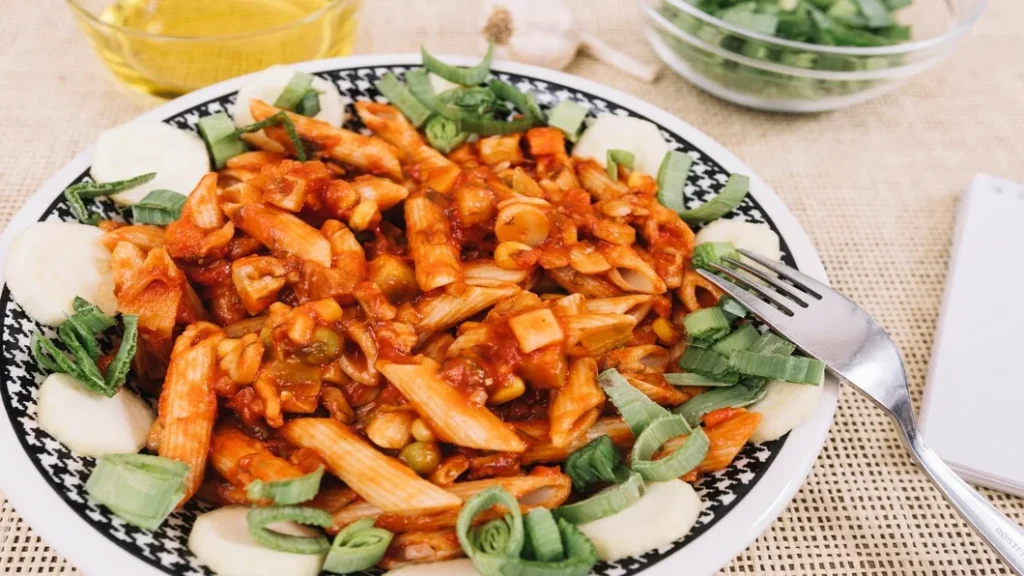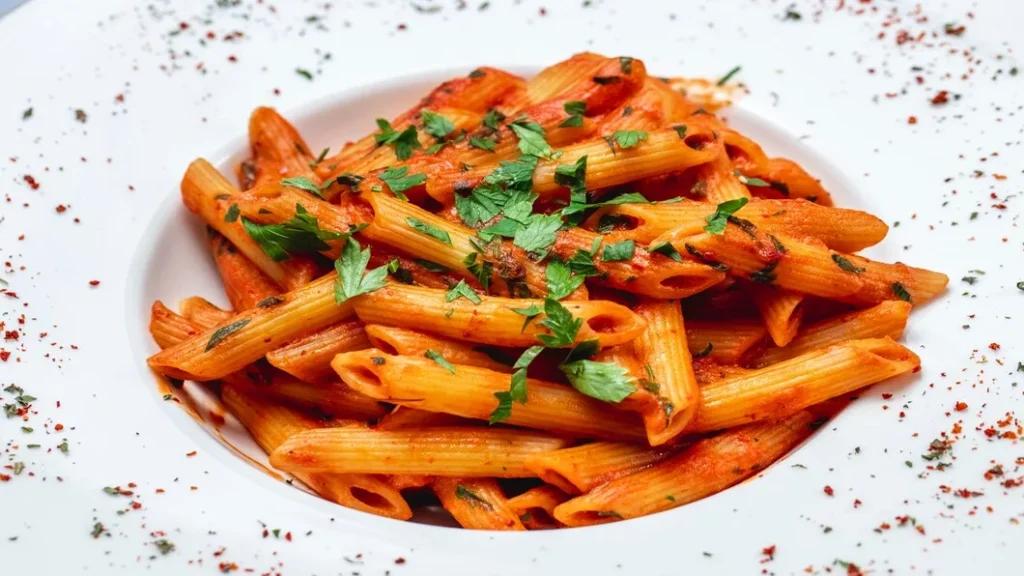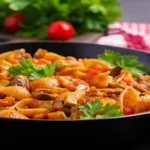Strozzapreti Norcina: Discover the Authentic Recipe and Rich History
Strozzapreti Norcina: Authentic Recipe & History unveils the delectable union of handmade pasta and a rich, flavorful sauce that has captured the hearts—and stomachs—of food lovers. This dish not only represents the culinary artistry of Umbria but also serves as a delicious link to Italy’s vibrant history. As we embark on this gastronomic journey, prepare to immerse yourself in the fascinating tales, techniques, and traditions that bring Strozzapreti and Norcina together.
Introduction to Strozzapreti Norcina
Strozzapreti pasta is a unique and hand-rolled creation that hails from the heart of Italy. Characterized by its twisted rope-like shape, this pasta is a joy to both make and savor. It captures the essence of traditional Italian cuisine: simple yet extraordinary ingredients coming together to create something truly special.
Integral to the dish is the Norcina sauce, a classic preparation from the town of Norcia in Umbria. Known as the land of black truffles and exceptional cured meats, Norcia has enriched Italian culinary culture with flavors that resonate throughout the country. The combination of Strozzapreti with Norcina sauce creates a dish that pays homage to Umbrian heritage while delighting the palate.
In the following sections, we’ll take a deep dive into the origins of Strozzapreti, explore the intricacies of Norcina sauce, and provide you with an authentic recipe that you can recreate in your own kitchen.
The Origins of Strozzapreti
Strozzapreti pasta embodies a rich historical narrative that stretches back centuries. Its roots are entwined with local folklore, agricultural traditions, and cultural exchanges that have shaped Italian gastronomy.
Historical Background of Strozzapreti Pasta
The origin of Strozzapreti can be traced to the Emilia-Romagna region, although it is now celebrated throughout various parts of Italy. Traditionally, this pasta was made by housewives who would roll the dough into ropes and twist it into bite-sized pieces. The name “Strozzapreti”, which translates to “priest choker,” is often believed to derive from local anecdotes where priests, known for their hearty appetites, found themselves choking on the thick pasta they were served.
This humorous yet evocative tale highlights how food is woven into the fabric of regional identity. As pasta became more than just sustenance, it grew into a source of pride and cultural expression, leading to different interpretations across Italy.
Linguistic Roots and Meaning of “Strozzapreti”
Examining the etymology of “Strozzapreti” opens a window into the cultural nuances of Italian language and tradition. The term itself stems from a couple of possible narratives: one suggests it reflects the way gluttonous priests would consume the pasta rapidly, while another indicates that it was originally named after the tension created when twisting the dough.
The linguistics behind food names often offer insight into customs, social hierarchies, and even trends in cooking practices through the ages. In the case of Strozzapreti, it signifies the intersection of humor and reverence within Italian culinary discourse.
Regional Variations Across Italy
While the classic form of Strozzapreti is cherished in Umbria and Emilia-Romagna, adaptations abound throughout the country. For instance, in parts of Liguria, you might encounter a thinner version called “Strangozzi,” which shares similarities in shape but may differ in preparation and sauces.
Each variation tells the story of local ingredients, tastes, and traditions, illustrating how the essence of a dish can shift while still retaining its core identity. This adaptability speaks volumes about Italy’s diverse culinary landscape and showcases how regional specialties contribute to the richness of national cuisine.
Understanding Norcina Sauce
Norcia, the birthplace of Norcina sauce, is renowned for its robust flavors and artisanal products. The sauce itself is deeply embedded within the Umbrian culinary tradition, serving as a testament to the simplicity and depth of Italian cooking.
Definition and Characteristics of Norcina Sauce
Norcina sauce is characterized by its creamy texture and savory flavor profile. It typically features elements such as pork sausage, cream, white wine, and herbs. Unlike heavier sauces that overwhelm the palate, Norcina strikes a balance between indulgence and restraint, allowing each ingredient to shine through.
The beauty of Norcina lies in its versatility; while the foundational components remain consistent, home cooks often tailor the recipe to their preferences, making it a dynamic addition to the Italian culinary repertoire.
Key Ingredients Typical to Norcina Sauce
At the heart of Norcina sauce is high-quality sausage, often infused with spices like fennel or chili flakes. The choice of meat significantly influences the final taste, emphasizing the importance of sourcing top-notch products.
Cream adds a luscious texture, while a splash of white wine elevates the flavor, providing acidity that cuts through the richness. Traditionalists may incorporate additional ingredients such as Parmigiano-Reggiano or nutmeg, enhancing the complexity of this beloved sauce.
The Role of Sausage in Traditional Recipes
Sausage is not merely an ingredient in Norcina sauce—it’s the star. The method of preparation and quality of sausage directly impact the overall flavor. Many families have their preferred vendors or recipes for sausage, reflecting personal ties to local producers and culinary legacies.
When crafting Norcina, the sausage must be sautéed until browned, allowing fats to render and mingle with other constituents. This step ensures a depth of flavor that transforms a simple sauce into an unforgettable experience.
Ingredients for Strozzapreti Norcina
To create a dish that honors tradition while tantalizing the palate, it’s imperative to gather high-quality ingredients. Below is a comprehensive guide on what you’ll need.
Strozzapreti Norcina:List of Essential Ingredients for Making Strozzapreti
For the pasta itself, you will require:
- Flour – Use high-protein flour, such as 00 flour, to give the dough elasticity.
- Eggs – Fresh eggs enhance richness and color.
- Salt – A pinch of salt elevates the flavor of your pasta. For the Norcina sauce, the essential ingredients include:
- Pork sausage – Fresh and flavorful, ideally sourced from local butchers.
- Heavy cream – To create a creamy base that binds the sauce.
- White wine – Adds depth and brightness.
- Garlic and onion – Aromatic bases that introduce layered flavors.
- Herbs – Such as parsley or sage for garnish.
These ingredients come together to form a comforting yet sophisticated meal that evokes the spirit of Italian cuisine.
Strozzapreti Norcina:Recommendations for Selecting Quality Ingredients
When it comes to Italian cooking, the mantra “less is more” rings true. Focusing on the quality rather than quantity of ingredients can profoundly impact the outcome of your dish.
Seek out artisan producers for your sausage and dairy. Visit local markets to find fresh, seasonal vegetables and herbs. The flavor intensity from quality ingredients will translate into a superior dining experience, showcasing the integrity of your preparations.
Special Equipment Needed for Preparation
While creating Strozzapreti does not necessarily require specialized equipment, a few kitchen tools can enhance your cooking process:
- Pasta machine – While optional, it aids in achieving uniform thickness.
- Rolling pin – Essential for flattening the dough.
- Knife or bench scraper – For cutting the pasta into strips.
- Large pot – For boiling water and cooking the pasta.
Having these tools at hand will streamline your cooking process, allowing you to focus on perfecting the art of pasta-making.
Step-by-Step Guide to Making Strozzapreti
Creating Strozzapreti from scratch is a rewarding endeavor that connects you to centuries of culinary tradition. This section will walk you through the process, ensuring that your homemade pasta is a success.
Detailed Instructions on How to Prepare Strozzapreti Pasta from Scratch
Begin by combining the flour and salt in a mound on a clean countertop. Create a well in the center and crack the eggs into it. Gradually incorporate the flour into the eggs using a fork, kneading it into a cohesive dough once combined.
Knead the dough for about ten minutes until smooth and elastic. Wrap it in plastic wrap and let it rest for at least 30 minutes to allow the gluten to relax, making it easier to work with.
Tips for Achieving the Perfect Texture and Shape
After resting, cut the dough into manageable sections. Roll out each piece to about 1/8-inch thickness. Cut the rolled-out dough into strips roughly half an inch wide, then twist each strip to form its characteristic shape.
To achieve the perfect al dente texture, cook the pasta in salted boiling water until it floats—typically around two to three minutes. Remember that fresh pasta cooks much quicker than dried!
Common Mistakes to Avoid While Making Pasta
Homemade pasta is forgiving, but there are common pitfalls to watch out for. Firstly, avoid overworking the dough, as this can lead to toughness. Secondly, ensure you don’t skip the resting period; it’s crucial for achieving the right consistency.
Lastly, don’t rush the drying process if you plan to store some for later. Allowing pasta to dry slightly before cooking will enhance its firmness and prevent it from clumping.

Preparing the Norcina Sauce
With your Strozzapreti ready, it’s time to turn our attention to the harmonious Norcina sauce, a vital component that brings the dish to life.
Step-by-Step Process for Creating Authentic Norcina Sauce
Start by heating a generous drizzle of olive oil in a large skillet over medium heat. Add finely chopped onions and garlic, sautéing until translucent and fragrant. Then, crumble the sausage into the pan, breaking it apart with a spatula and browning it evenly.
Once cooked, pour in a splash of white wine, scraping any flavorful bits from the bottom of the pan. As the wine reduces, add heavy cream gradually, stirring continuously to create a velvety mixture.
Cooking Techniques to Enhance Flavors
Enhancing flavors involves patience and finesse. Allow the sauce to simmer gently, letting it thicken while stirring regularly. Incorporate herbs at the end to maintain their freshness. If desired, adjust spice levels by adding crushed red pepper or black pepper for heat.
Taste and season accordingly. Remember that the sausage contributes significant flavor, so be cautious with added salt.
Suggestions for Adjusting Spice Levels and Richness
Tailoring the spice levels and richness is a personal touch that makes the dish your own. For milder flavors, opt for sweet Italian sausage and reduce the amount of black pepper.
Conversely, if you prefer a kick, consider adding spicy sausage or incorporating chili flakes. Adjust the cream content based on your preference for richness, balancing between light and indulgent.
Combining Strozzapreti and Norcina Sauce
Finally, the moment you’ve been waiting for arrives: combining the freshly made Strozzapreti with the luscious Norcina sauce.
Instructions on How to Properly Combine the Pasta with the Sauce
Once the Strozzapreti pasta is cooked to perfection, reserve a cup of pasta water before draining. In the skillet with the Norcina sauce, add the drained pasta directly into the sauce, tossing gently to coat.
If the sauce appears too thick, use reserved pasta water to loosen it up, creating a silky texture that envelops each piece of pasta. The goal is a harmonious blend, where neither the pasta nor the sauce overshadows the other.
Recommended Cooking Time for Optimal Flavor Integration
Allow the combined pasta and sauce to simmer for a minute or two, ensuring that the flavors meld beautifully. Taste for seasoning one last time, adjusting if necessary.
This brief cooking time allows the pasta to absorb some of the sauce’s flavor without overcooking, maintaining that delightful bite.
Additional Toppings to Enhance the Dish
To elevate your Strozzapreti Norcina, consider adding grated Parmigiano-Reggiano or Pecorino Romano for a salty finish. Fresh herbs, such as parsley or basil, can introduce a pop of color and freshness, complementing the richness of the dish.
A drizzle of high-quality extra virgin olive oil or a sprinkle of toasted pine nuts can further enhance your presentation, turning a comforting dish into a culinary masterpiece.
Serving Suggestions
How you present and serve Strozzapreti Norcina can further amplify its appeal, turning a simple meal into an occasion worthy of celebration.
Traditional Serving Styles for Strozzapreti Norcina
Traditionally, Strozzapreti Norcina is served hot, straight from the pot. Consider plating the pasta in shallow bowls, allowing guests to fully appreciate the saucy goodness.
Garnish with freshly grated cheese and herbs, inviting diners to indulge in the dish. Family-style serving, where everyone shares from a communal bowl, fosters connection and mirrors the Italian philosophy of enjoying meals together.
Wine Pairings That Complement the Dish
Pairing wine with Strozzapreti Norcina requires careful consideration to balance the richness of the sauce. A full-bodied white wine, such as Verdicchio or a light red like Chianti, complements the dish beautifully.
For those who lean toward bold choices, a Sangiovese enhances the flavors while respecting the dish’s heritage. Offering a selection allows guests to choose their preference, enriching the dining experience.
Presentation Tips for an Appealing Dining Experience
Presentation matters, especially when celebrating such a beautiful dish. Use warm plates to serve, ensuring the Strozzapreti remains inviting. Consider layering flavors visually by arranging pasta first, followed by sauce, toppings, and finally a sprinkle of fresh herbs or cheese.
Don’t forget about table settings! Simple touches like cloth napkins, rustic wooden serving boards, and candlelight create an inviting atmosphere that encourages conversation and enjoyment.

The Cultural Significance of Strozzapreti Norcina
Beyond its delicious taste, Strozzapreti Norcina carries profound cultural significance within Umbrian society, representing shared traditions and family values.
Role of Strozzapreti Norcina in Umbrian Celebrations and Gatherings
Strozzapreti Norcina frequently graces tables during family gatherings, holidays, and festivals. It symbolizes warmth, unity, and the pleasure of sharing meals with loved ones.
During celebrations such as Christmas or Easter, it takes center stage alongside other traditional dishes, reminding diners of their heritage and the stories passed down through generations.
Storytelling and Folklore Surrounding the Dish
The tales surrounding Strozzapreti often weave into the fabric of community folklore. They tell of family feasts, culinary competitions, and beloved grandmothers imparting secret recipes to eager grandchildren.
Such stories highlight the emotional connection people have with food—how it brings them together and nurtures bonds that extend beyond the dining table.
How It Reflects the Culinary Heritage of Italy
As a representative dish of Italian heritage, Strozzapreti Norcina encapsulates the artistry of fresh ingredients, time-honored techniques, and regional pride. Each bite transports the diner to the lush landscapes of Umbria, inviting them to appreciate the culture’s deep-rooted respect for food and family.
Through the lens of this dish, one can better understand Italian values, where culinary practices intertwine with identity, nostalgia, and love.
Variations of Strozzapreti Norcina
Innovation and creativity breathe new life into traditional recipes, resulting in exciting variations of Strozzapreti Norcina.
Modern Twists on the Classic Recipe
Modern chefs and home cooks alike are experimenting with innovative ingredients, leading to delightful departures from the classic recipe. Consider incorporating wild mushrooms, asparagus, or roasted vegetables to diversify flavors and textures.
Alternatively, experiment with different types of sausage or even plant-based substitutes to cater to various dietary needs while staying true to the comforting essence of the dish.
Vegetarian and Vegan Adaptations
Vegetarian adaptations of Strozzapreti Norcina can easily replace sausage with robust veggies or legumes, crafting a hearty alternative that doesn’t compromise on flavor.
For vegan versions, utilize cashew cream or coconut milk, along with vegetable broth, to mimic the richness of the original sauce while embracing plant-based principles.
Regional Variations Within Italy
Italian cuisine thrives on diversity, with each region celebrating its approach. In Bologna, for instance, you might find Strozzapreti tossed in ragu rather than Norcina sauce. Similarly, in southern regions, a fresh tomato sauce could accompany the same pasta.
Exploring these variations invites you to appreciate the multifaceted nature of Italian culinary traditions, reminding us that every region holds a unique story waiting to be told.
Frequently Asked Questions About Strozzapreti Norcina
Curious cooks often have questions regarding the preparation of Strozzapreti Norcina. Here, we tackle some of the most common queries.
Common Queries Regarding Preparation and Ingredients
What type of sausage is best for Norcina? While traditional recipes call for pork sausage, feel free to experiment with chicken or turkey sausage for a leaner option.
Can I make Strozzapreti ahead of time? Yes! You can prepare the pasta in advance and store it in the refrigerator. Just remember that fresh pasta cooks quickly, so adjust cooking times accordingly.
Troubleshooting Common Issues Faced by Cooks
What if my dough is too sticky? If your pasta dough feels sticky, gradually add more flour while kneading until the desired consistency is reached.
How can I fix a bland Norcina sauce? If your sauce lacks flavor, consider adding more herbs, spices, or even a dash of vinegar to brighten it up.
Tips for Storing Leftovers and Reheating
To store leftovers, place Strozzapreti and sauce separately in airtight containers in the refrigerator. They should keep well for a couple of days.
To reheat, gently warm the sauce on the stovetop while cooking the pasta separately. This helps preserve the sauce’s flavor and prevents overcooked noodles.
Conclusion
As we conclude our exploration of Strozzapreti Norcina: Authentic Recipe & History, it’s clear that this dish transcends mere nourishment. It embodies the spirit of Umbria and resonates with the heart of Italian culture.
From its historic roots and charming folklore to the intricacies of its preparation, Strozzapreti Norcina invites all to experience the joys of Italian cuisine. Whether you’re preparing this dish for a family gathering or indulging in a quiet evening at home, remember that food holds the power to connect, nurture, and inspire—a beautiful reminder of the rich history and flavors that define our culinary heritage.
Discover our Julia Child Buttercream recipe for your next dessert! Check it out here!

Strozzapreti Norcina: Discover the Authentic Recipe and Rich History
- Total Time: 30 minutes
- Yield: 4 servings 1x
Description
Norcina Sauce is a rich and creamy pasta sauce originating from the Umbrian region of Italy. Made with Italian sausage, cream, white wine, and a touch of Parmesan, this luxurious sauce pairs beautifully with pasta for a comforting, hearty dish that’s perfect for any occasion.
Ingredients
For the Sauce:
- 2 tablespoons olive oil
- 1 small onion, finely chopped
- 2 garlic cloves, minced
- 1 lb (450 g) Italian sausage (mild or spicy), casings removed
- 1/2 cup dry white wine
- 1 cup heavy cream
- 1/2 cup grated Parmesan cheese
- Salt and black pepper, to taste
- Pinch of nutmeg (optional)
- 2 tablespoons chopped fresh parsley (for garnish)
For Serving:
- 12 oz (340 g) pasta (penne, rigatoni, or fettuccine work well)
- Extra grated Parmesan cheese
Instructions
-
Cook the Pasta:
- Bring a large pot of salted water to a boil. Cook the pasta according to package instructions. Reserve 1/2 cup of pasta water before draining.
-
Sauté the Aromatics:
- Heat olive oil in a large skillet over medium heat. Add the chopped onion and sauté for 3-4 minutes, until softened. Add the minced garlic and cook for another 30 seconds, stirring frequently.
-
Cook the Sausage:
- Add the Italian sausage to the skillet, breaking it up with a wooden spoon. Cook for 5-7 minutes, or until browned and fully cooked.
-
Deglaze with Wine:
- Pour in the white wine, scraping up any browned bits from the bottom of the pan. Let it simmer for 2-3 minutes, allowing the alcohol to evaporate.
-
Add Cream and Cheese:
- Reduce the heat to low. Stir in the heavy cream and Parmesan cheese. Add a pinch of nutmeg if desired. Simmer gently for 5 minutes, stirring occasionally.
-
Combine Pasta and Sauce:
- Add the cooked pasta to the sauce, tossing to coat. If needed, add reserved pasta water, a tablespoon at a time, to loosen the sauce to your desired consistency.
-
Serve:
- Divide the pasta among plates or bowls. Garnish with fresh parsley and extra Parmesan cheese. Serve immediately.
Notes
- Vegetarian Option: Substitute sausage with sautéed mushrooms for a meatless version.
- Cheese Variation: Try Pecorino Romano instead of Parmesan for a sharper flavor.
- Storage: Leftovers can be stored in an airtight container in the fridge for up to 3 days. Reheat gently over low heat with a splash of cream or milk.
- Prep Time: 10 minutes
- Cook Time: 20 minutes
- Category: Main Dish
- Method: Sautéed
- Cuisine: Italian
Nutrition
- Serving Size: 1 serving (1/4 recipe)
- Calories: 520
- Sugar: 3g
- Sodium: 780mg
- Fat: 35g
- Saturated Fat: 15g
- Unsaturated Fat: 18g
- Trans Fat: 0g
- Carbohydrates: 30g
- Fiber: 2g
- Protein: 20g
- Cholesterol: 90mg
Keywords: Norcina Sauce, Italian Cream Sauce, Pasta with Sausage, Creamy Pasta Sauce, Umbrian Recipe, Comfort Food

